Developer: Clifftop Games | Released: 2019 | Genre: Adventure, Point & Click
I’m changing my mind about canning the balanced reviews. I actually missed doing them. So I’m not going to rule them out after all. I’ll return to them again for a while to ascertain the format.
A solid retro adventure game much in the same vein as Technobabylon and Primordia. I was in a control of a female cop trying to solve a few murders in a small city located on a raised disc.
The developers called it a sci-fi nordic noir.
As the blonde protagonist, Vera Englund – still moaning the loss of her boyfriend – the game immediately started with her arriving at the first murder scene. There were just two screens to navigate here until I had reached a milestone. Then most of the city was available to me.
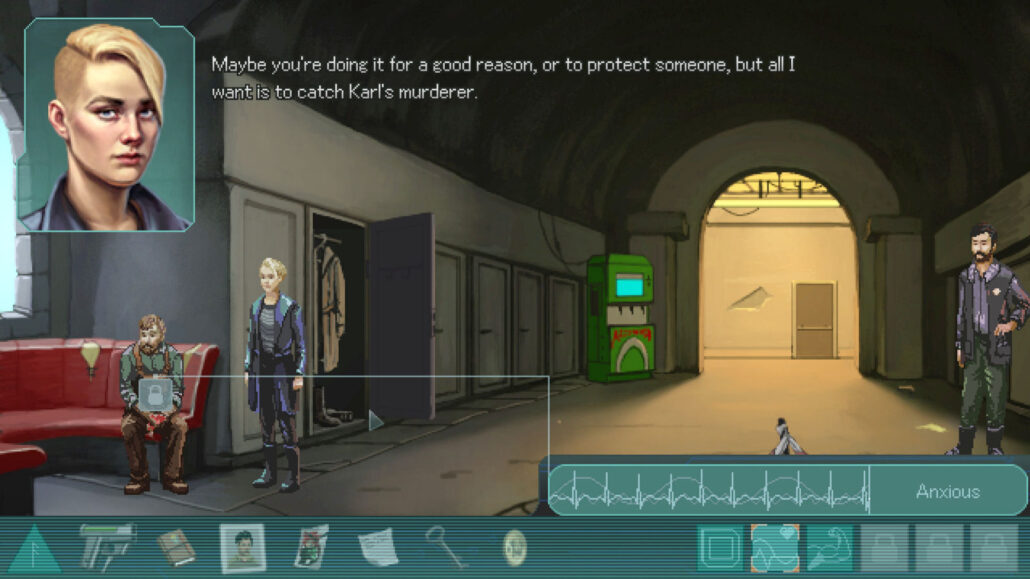
Apart from the classic point-and-click features with an inventory that can combine objects, there was a triangle for steering towards one of three paths depending on what dialog options where chosen along the way. Since I only played the game once, it didn’t feel like this affected the gameplay all that much.
My guess is it probably did affect what augmentations I was given.
Augmentations? Sure. This was a pretty cool feature and most unexpected to find in this type of game. It felt like it was inspired by Deus Ex. I had a few to begin with, and more were added during the game.
The initial augmentations could do stuff like give me added strength for lifting or pushing stuff, a Forensic Scanner for finding liquids or chemicals on the entire screen, and a Biometric Analyzer for spying on the heartbeat of another person. Getting stuck in this game could be hard work due to the Forensic Scanner. Think of all the screens that could be scanned, and for each of its collected modes too.
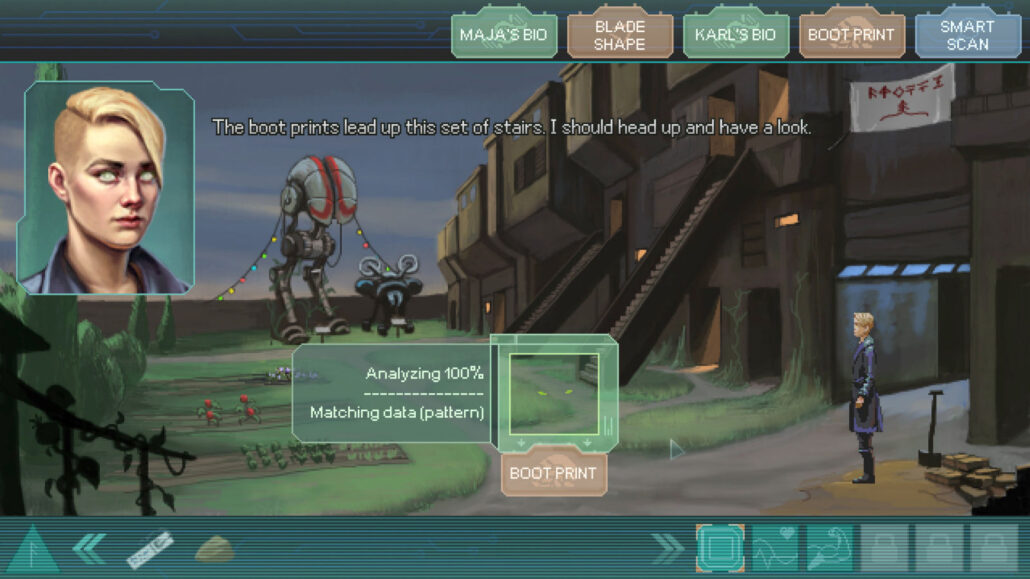
But it was possible to learn when it didn’t make sense to use the Forensic Scanner.
Another unusual feature of this adventure game was autosaving. There was no manual saving, apart from when quitting the game. I actually liked this since I didn’t have to bother saving all the time, but it’s true that it makes it difficult to reload and try out alternative solutions.
The adventure game itself was technically well done. The graphics were nice for being pixelated, the music was excellent, and the voice acting fine. If anything, it felt weirdly unfinished at times. Many locations were immediately blocked off after solving them instead of just being able to go there and waste time, and other locations couldn’t be visited at all – like a café close to a church, for example.
The protagonist reminded me of Tasha Yar from Star Trek: The Next Generation.
I wonder if that was deliberate?
It didn’t feel easy to game the path triangle. I basically just chose the dialog options I liked the best, without double-thinking it at all. You just do what you have to do, game.
I was stuck in the first scene with only two screens, until I discovered that using the Biometric Analyzer caught a heart beat anomaly in the witness to the first murder. I had to click the anomaly in the tool display to bring it up in conversation. This was the only occurrence of this solution.
A bit overwhelming leaving the first murder scene and getting into the city, although the developers were skilled enough to close off certain sections because of it not being relevant yet. Much appreciated.
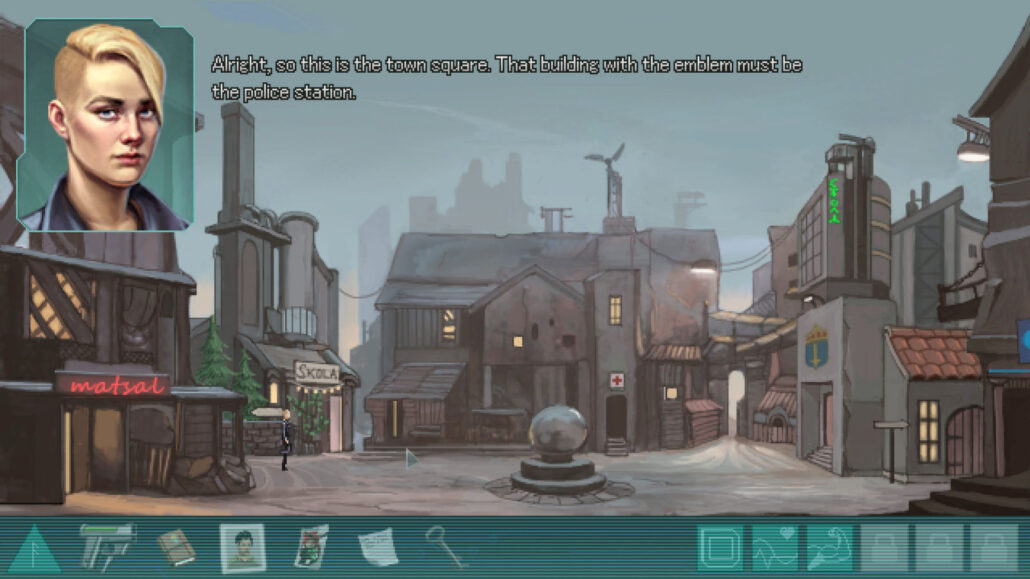
My first augmentation was the Enhanced Vision, for seeing in the dark and at a great distance.
The door scanner to the apartment needed a three digit code. Brute forcing it was not a good idea since each failed attempt ended with an error and a few beeps that lasted a few seconds each time.
Definitely deliberate programming there.
I quickly got a clue from a birth date and city entrance date of the apartment owner, but I had to type one of the attempts backwards before I got it right. I didn’t expect that to work since I had basically entered my usual mode of trying ridiculous things after a certain amount of failures.
I guess that method had to pay off eventually.
Reading the massive history plaques at the museum about how AI was banned after the Collapse gave me the impression this could be a world after one of the endings of the original Deus Ex game.
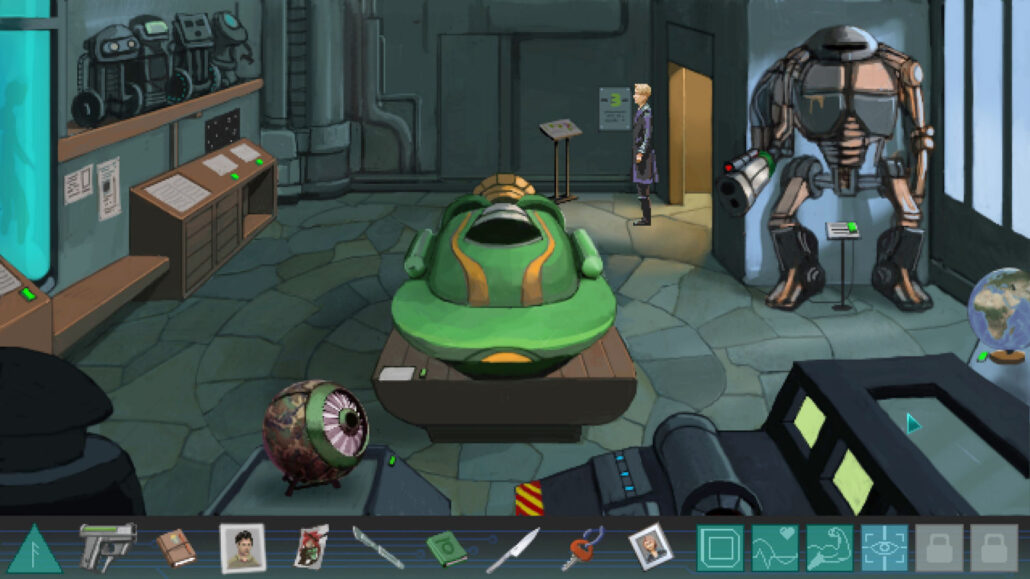
I was stuck for quite a while looking for that food canister. I visited the museum several times, scanning everything. After reading about the “Path of the Pilgrim” repeated both in the upstairs apartment and in the museum, it suddenly dawned on me. I looked in the green Conduit book about a path, and it did have four vague descriptions for faith, skies, a strike and a full day. Those moves could be replicated by pressing museum display buttons for similar objects, and that in return opened a secret door.
I’m so glad I had this epiphany. I was this close to consulting a walkthrough.
My second augmentation was Mimicry, the ability to mimic the appearance of someone else.
It didn’t look convincing to me – barely a hologram covering one side of the top half of the body. What kind of eagle eye could possible penetrate that kind of disguise? But a complete replacement of the animated character would mean more work for the developer, so I do understand why they cut that corner.
The street artist drew flowers on the wall the next day. “I was right about the flowers” – were you? Or did the developers choose what I thought it looked like in so many words to the artist the day before?
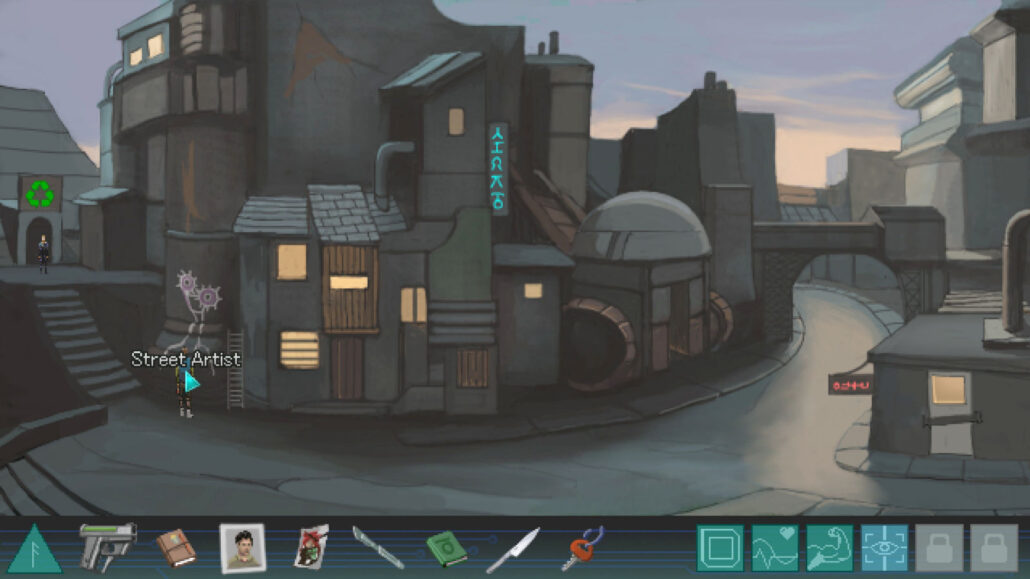
I’m not going to replay the game to find out. You tell me.
I liked having to push a tall filing cabinet (used to reach a ventilation grating in the ceiling) in perfect timing to the drilling noise in a room nearby. If I didn’t time it correctly, a guard would hear me push the cabinet and sound an intruder alert. I couldn’t help but think of Andy Dufresne in Shawkshank Redemption, hitting a sewer pipe with a rock every time lightning and thunder stroke.
Nice puzzle removing noise from a recording using features right out of an app like Audacity.
I saw a mile away that Stina Rooth would be the main antagonist of the game. Probably guessed it the first time Vera had to report back to her.
Damn me having watched so many movies in my life.
What I didn’t predict was how Stina later tried to kill Vera. She used an invisibility augmentation, waited for Vera to climb to the edge of the city to grab a magenta scarf that looked liked evidence, then pushed her down from the entire city disc. Reminded me of the first episode of the second season of Silo.
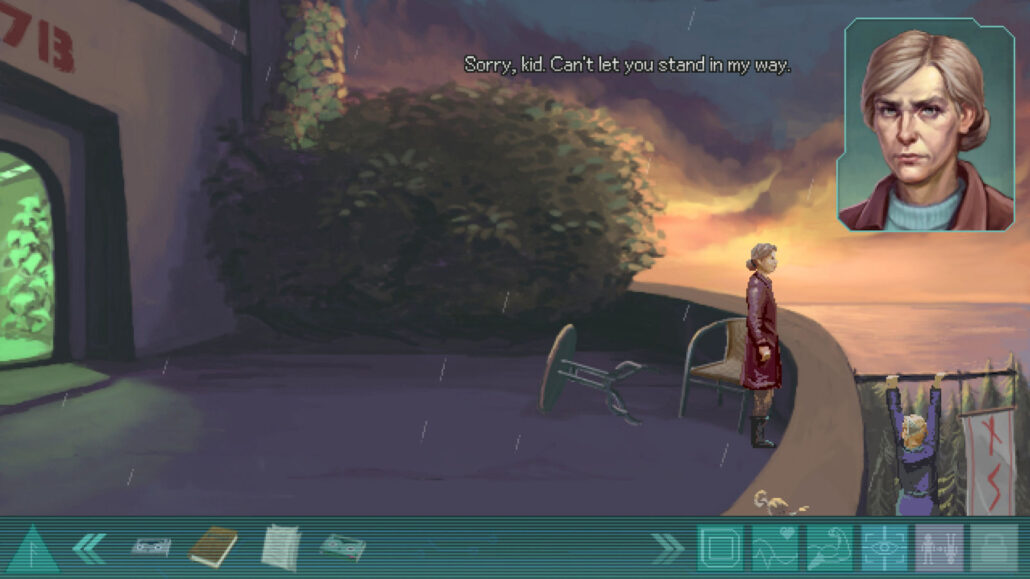
Shortly after that she gained the Regeneration augmentation. Quite useful then and there.
Also unusual having to cut herself in the jail cell to get the guard to unlock the door, then use Regeneration and sprint out of there. Not going to trick the guard in the classic adventure game ways this time.
I really liked how Vera revived the school teacher by plugging up with an IV and then using Regeneration. The developers sure had a lot of imaginative ideas for how to make use of such an augmentation.
That jump scare with the bird – why was that added? Just to spice it up? Or to use an animation asset that sadly wasn’t used for anything else?
Damn that last sequence confronting Stina. She was fast and easily shot Vera. Figuring out how to turn on the rocket on a vehicle to make Stina look away wasn’t intuitive since I had to pay attention to Stina’s pixelated head turning to the side. That sure was subtle.
Until I figured that out, I actually tried going through the “Path of the Pilgrim” sequence both forwards and backwards, hoping to close the door and lock Stina up inside the secret room. But the fact that I didn’t have the green book at that time indicated this was probably not the way.
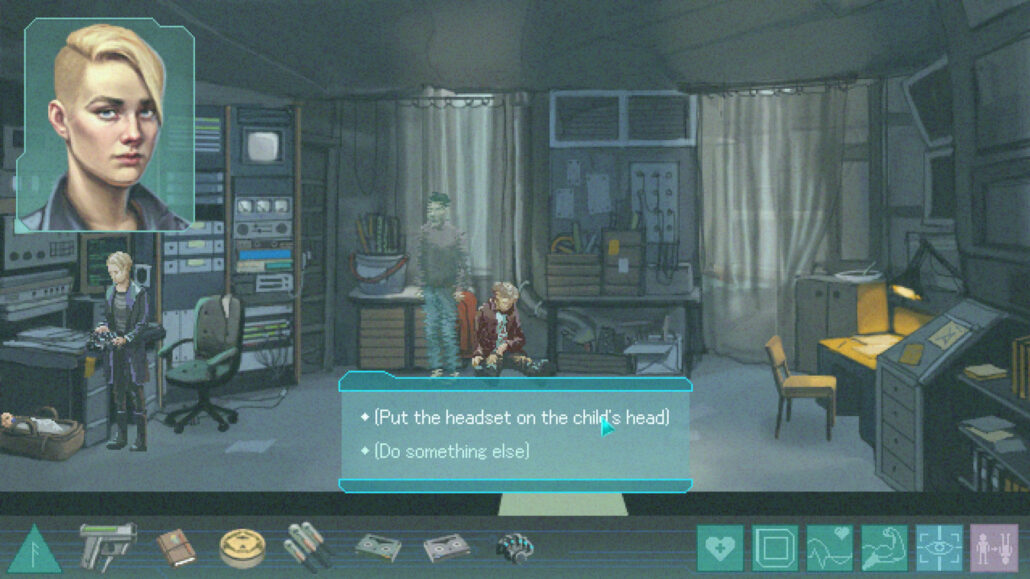
That being said, I really liked the oomph in Vera’s gun. Boom, boom, boom. It could have been used in a juicy FPS. Stina went down, and then I activated a console and were offered two options. Huldra; join the AI and the baby, or Fenrir; wipe out the program.
I was way too curious not to select the Huldra option.
Vera’s deceased boyfriend Alex popped up as a ghost from time to time. In the beginning he was friendly and their relationship was spot on – but later he started getting a tad antagonistic along with a secondary voice deviating from his major voice. I chose the Huldra ending where the AI was merged into the baby, and since this was what Alex wanted, I didn’t get into trouble with him.
Turned out I had chosen the empathic path.
Pros
- Well crafted pixelated graphics, music and good voice acting.
- The autosaving frees you from having to save manually all the time.
- More augmentations are added to help solve puzzles, no doubt inspired by Deus Ex.
- Refreshingly different kind of solutions, often due to those augmentations.
- A choice between three types of personality paths for replaying the game.
- Double-clicking an exit immediately teleports to it.
- Vera automatically updates her journal with new dialog options.
Cons
- Some locations are quickly eliminated, others are not used at all.
- The autosaving makes it difficult to reload and test out other solutions.
- If you get stuck, the Forensic Scanner can exacerbate it further.
By the way, there was a design error in the side-scrolling walking sequence along a road – for example as could be seen in the end right before the credits. The edge of the road farthest away from the player scrolled faster than the edge closest to the player. That should have been the other way around.



